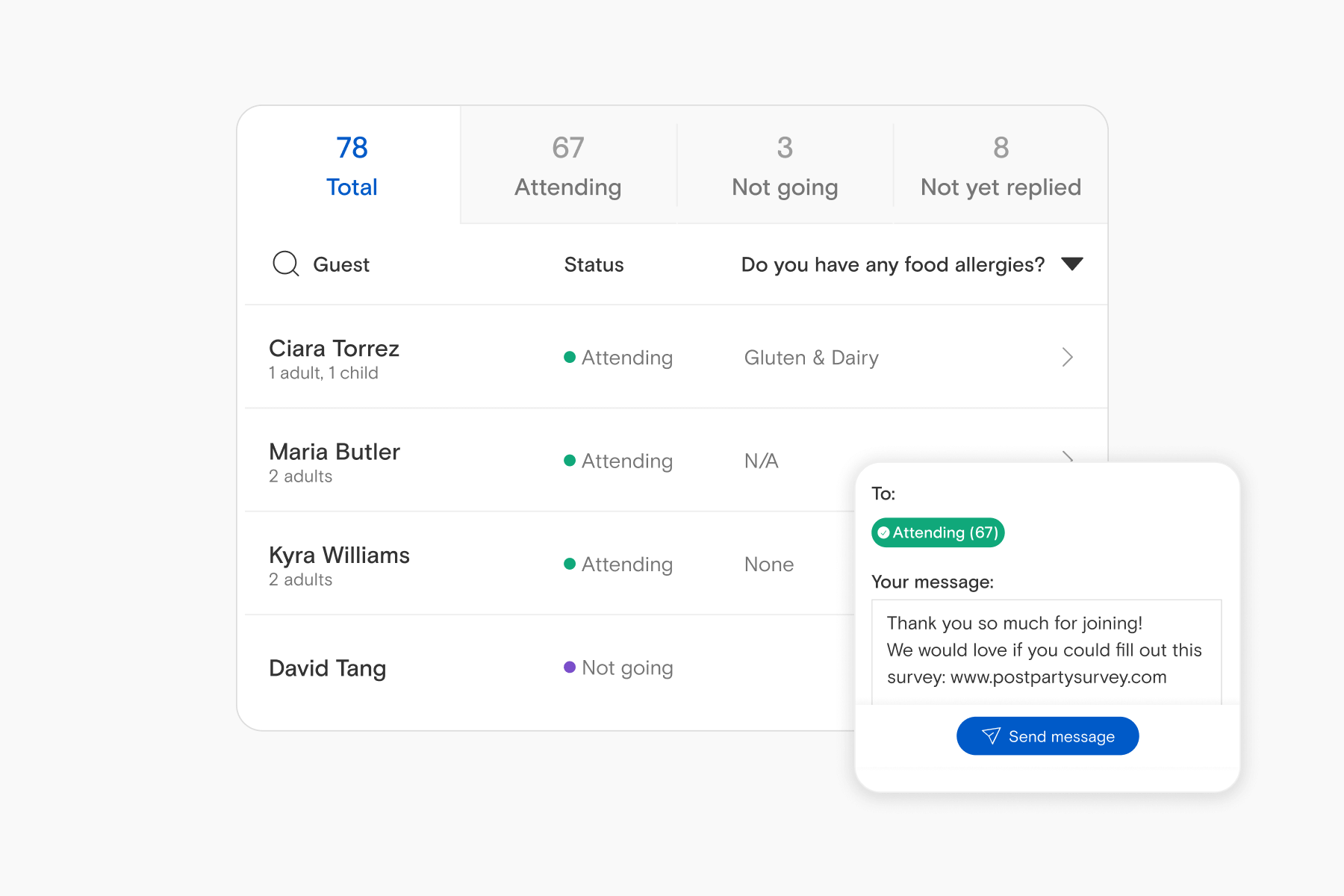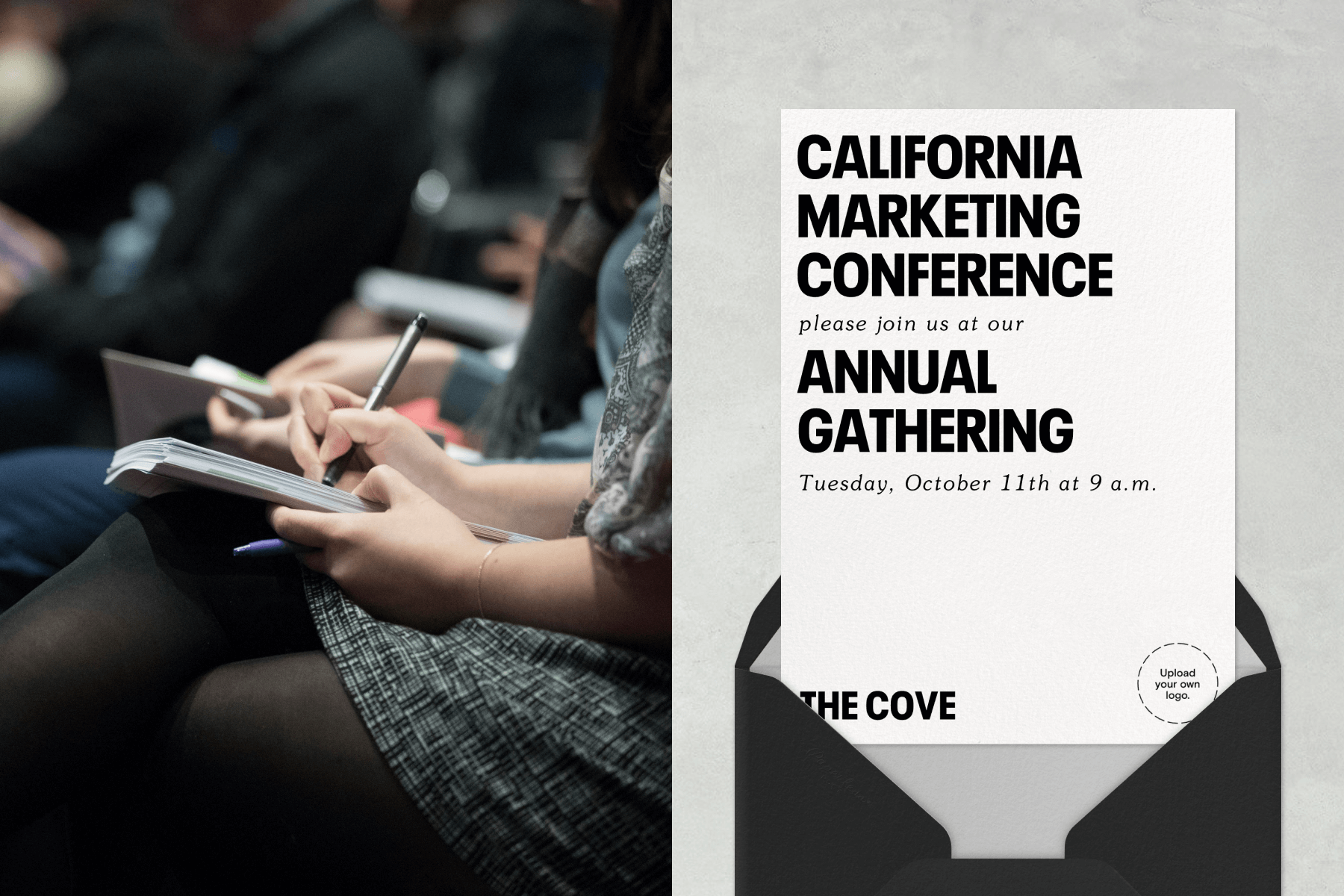8 useful KPIs for measuring event success

You’ve just wrapped up an event—but how can you measure how successful it was? Key performance indicators (KPIs) measure event success in quantifiable ways, letting you know where you met your goals and where you can improve for next time. Learn how to measure event success with a variety of event KPIs and metrics, and how Paperless Pro can help you meet those goals with intuitive tools and features.
Table of Contents
1. Total number of attendees

One success indicator is the number of guests that attended your event. While Paperless Pro’s business event invitations let you track RSVPs as they come in, those RSVPs may not add up to your actual number of attendees—which is where tracking attendance with guest check-ins comes in. Tracking guest check-ins can tell you the following:
- Whether you have a strong conversion rate between those who registered for the event and those who attended
- If your RSVPs and/or event registrations accurately correspond to actual event attendance
- Whether more guests registered and attended this year’s event as opposed to last year’s event
- Whether your event’s actual attendance hit your planning goals
Download the Paperless Post app to start using our Guest Check-In feature when guests arrive at your event, letting you start your KPI analysis ASAP. If you encounter discrepancies between registration rates and guest check-ins, dig in to find out why that may have occurred. Is there anything you can do in the future to keep guests excited about your event after they’ve registered?
2. Post-event surveys

Post-event surveys are another helpful event KPI that let you know exactly what guests thought of your event. You can send these questionnaires right after the event for immediate impressions, or you can start collecting feedback before the event is even over. Surveys can include questions about the event as a whole or can inquire about different programs from the event, such as any seminars, presentations, or receptions.
Survey questions may include:
- What did you like about the event?
- What would you change about the event?
- Would you attend a similar event in the future?
- How would you rate the event (from 1-5)?
- Do you feel the event was worth attending?
- Would you like to receive communications about our organization in the future?
Send a survey link in a post-event Paperless Post broadcast message to anyone who RSVPed “Attending” to your invitation, or tailor your audience to those who actually attended. Participants are more likely to respond to shorter surveys, so focus on key factors that you’d like responses for.
3. Net promoter score (NPS)

Your event attendees may have enjoyed themselves—but how likely are they to recommend your company or organization to others? A net promoter score (NPS) is an effective event metric that determines how likely it is that attendees will become “promoters” of your event or organization.
Include the question, “On a scale of 1-10, how likely are you to recommend this event/product/company to people you know?” in your post-event survey. Results break down as follows:
- Promoters: Responses between 9-10
- Passives: Responses between 7-8
- Detractors: Responses between 0-6
Calculate your event’s NPS by subtracting the percentage of detractors from the percentage of promoters. An NPS between 20 and 50 indicates that your event was generally successful since more people were happy with the event than unhappy. An NPS above 50 demonstrates that your event was very successful, while a score above 70 suggests that your (extremely happy) guests may become active promoters of your product or organization.
4. Digital and social media event engagement
Social media event management is one of the most effective event marketing strategies available. Use this popular KPI to measure event success throughout your planning process, while the event takes place, and after the event is over. Markers of event success on social media may include:
- User engagement with event hashtags during and after the event
- Increased followers on your organization’s social media accounts
- Higher engagement with posts, including likes, comments, and reshares
- Social media mentions and tags
- Followers posting photos of the event on their own social media platforms
Have your PR or sales team monitor your organization’s social media accounts in the period before, during, and after your event. See if they can prepare a presentation—differentiated by platform, if necessary. If you see a large engagement spike after the event, consider increasing your social media presence with desirable platforms or keywords and follow other organizations that share your company’s audience, goals, and vision.
5. Post-event engagement

Digital event success metrics don’t stop at social media. You can track guest engagement with your organization long after your event has concluded. Try these performance measurement strategies to see how much your event impacted your digital footprint.
- When you send invitations online with Paperless Pro, analyzing engagement with your event invitation is easier than ever. Our Advanced Analytics view features easy-to-read graphics for delivery status, responses, and event page views. Strong engagement with your invitation is a good leading indicator of success.
- Talk to event sponsors about whether they’ve seen an increase in digital engagement or business inquiries since participating in your event.
- Monitor overall traffic to your website, via the analytics platform of your choice to see if it has increased since hosting your event. Stay on top of any brand buzz by setting up Google Alerts to get notified about new brand mentions on the web.
Consider tracking post-event engagement over a longer period of time. A long-term KPI may be a more effective event metric compared to a sudden—and perhaps short-lived—spike in interest in the weeks following the event itself.
6. Leads generated
For events with sales-related goals, one element of impact measurement is how many leads your event generated. These events are often open to the public to extend reach as far as possible and include a variety of ways for guests to provide organizers with their contact information. These strategies include:
- Subscribing to the organization’s email list
- Submitting email or other contact information
- Filling out an interest form
- Adding business cards or contact information to an event raffle
- Following an organization’s social media profiles
After your event is over, make sure to add these leads to your Paperless Post Address Book as well as your internal lead sheet. That way, you can include them in any upcoming events and communications. Bring the sales department in on this analysis and see whether they’ve noticed an increase in calls or other contacts since the event.
7. Event revenue
“Red Square Border” by Paperless Post; “Modest Dazzle” by Paperless Post
ALT: A silent auction invitation with dark red cursive lettering and a dark red border; A black invitation with gold stars and text reading ‘GOLDEN THREAD GALA’.

A popular event KPI includes calculating how much revenue your event generated. Especially effective for fundraisers, tradeshows, and other promotional events, this KPI is straightforward and directly connected to event goals. It can also tell you how much you can expect to bring in at the event next year—or if you need to adjust your forecast and goals accordingly.
Revenue-raising elements of a professional event may include:
- Ticket/registration sales
- Tickets to individual events, such as speakers or panels
- Money made from raffles, auctions, or smaller fundraisers within the event
- Sponsorships and donations
- Sales of your product or service during and after the event
8. Number of new vs. return attendees
Measuring your number of new and repeat attendees is a long-term performance KPI that benefits your planning process for years to come. Not only can you analyze whether your event attracts new guests, but you can also assess long-term success by determining how many returning attendees continue to support your organization. Ideally, a successful event enjoys a balance of return vs. new guests, with a slight edge on guests you’ve engaged with before.
This event metric can determine:
- Guest satisfaction with previous events
- Effectiveness of your event’s marketing and communications
- How much programming you should change in your event (or how much you should keep the same)
Use Paperless Post Guest Tags to organize guests into new or returning participants in your event, and easily export your guest list to see the percentage breakdown of each type of guest.
To encourage repeat attendees, include details, pictures, and highlights from the event in your next email newsletter to recognize guests who attended (and intrigue those who didn’t).
Plan your next event with Paperless Pro

Whether you’re planning a corporate seminar or a charity fundraiser, Paperless Pro has everything you need to plan—and analyze—a successful event.
Already thinking about planning your next event? Follow our guide to the best event management tools for any type of event, or take a look at our thorough corporate event planning guide for more ideas on throwing an event that keeps everyone talking. And if you’re looking for something truly unique, our ideas for client appreciation events help you reach your goals—and keep your brand top-of-mind.
Find sophisticated, business-minded designs that streamline planning and impress guests.

